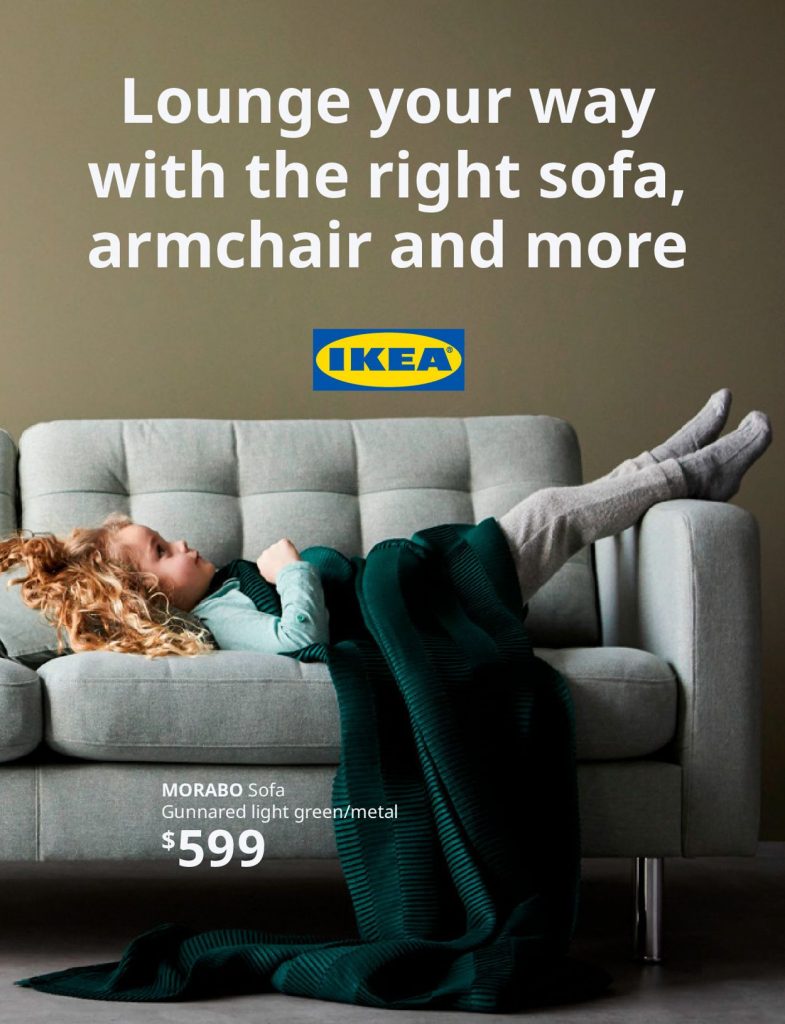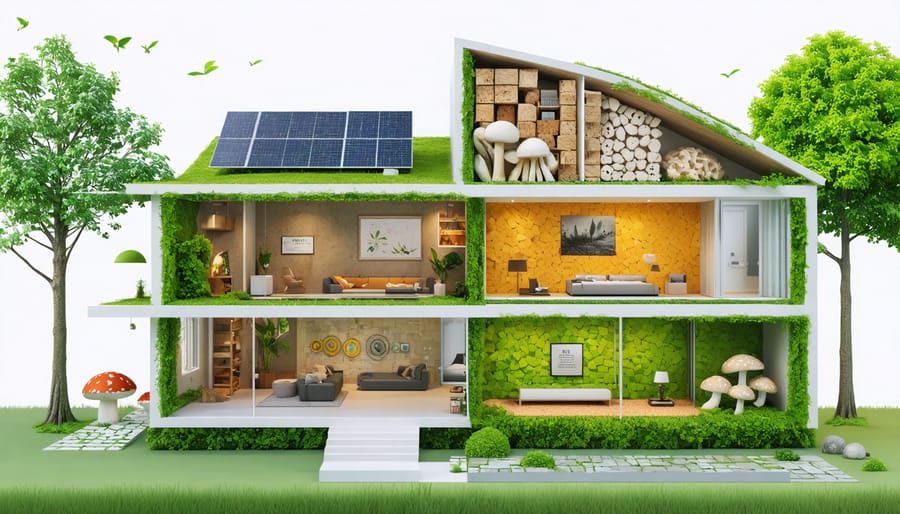
Green Insulation That Actually Saves You Money (And The Planet)
Transform your home’s energy efficiency with advanced green insulation technologies that combine sustainable materials with cutting-edge thermal performance. Today’s eco-friendly insulation solutions deliver superior R-values while reducing your carbon footprint and energy bills. From recycled denim and mushroom-based compounds to advanced aerogels and phase-change materials, green insulation has evolved far beyond traditional fiberglass batts.
Modern sustainable insulation options now match or exceed conventional materials in performance, offering remarkable benefits like sound dampening, moisture resistance, and fire protection. These innovative solutions are increasingly cost-competitive, with many products paying for themselves through energy savings within 3-5 years. Whether you’re retrofitting an existing structure or planning new construction, green insulation materials provide a perfect blend of environmental responsibility and practical efficiency.
Leading architects and builders are embracing these advanced solutions, recognizing that sustainable insulation isn’t just about environmental impact – it’s about creating healthier, more comfortable living spaces while reducing long-term operating costs. With options ranging from natural wool to high-tech recycled composites, today’s green insulation materials offer unprecedented choice and performance for every application and budget.
Next-Generation Plant-Based Insulation Materials
Hemp and Cotton Insulation
Hemp and cotton insulation products represent some of the most sustainable options in eco-friendly home insulation. These natural fiber materials are renewable, biodegradable, and often made from recycled content, particularly in the case of cotton insulation, which frequently incorporates recycled denim.
Hemp insulation comes in batts or rolls and offers excellent thermal performance with an R-value of 3.5 per inch, comparable to traditional fiberglass. It’s naturally resistant to mold, pests, and fire, making it an excellent choice for both walls and attics. Installation is straightforward – the batts can be cut to size with standard tools and fit snugly between studs without requiring protective gear.
Cotton insulation, primarily made from recycled blue jeans, is equally user-friendly for DIY installation. It doesn’t contain harmful chemicals or irritants, eliminating the need for protective equipment during handling. With an R-value of 3.7 per inch, it provides effective temperature control while also offering superior sound dampening properties.
Both materials excel at moisture management, naturally absorbing and releasing humidity without compromising their insulating properties. This helps prevent mold growth and maintains healthy indoor air quality. While these options typically cost 20-30% more than conventional insulation, their durability and environmental benefits often justify the investment, especially for environmentally conscious homeowners looking for long-term solutions.
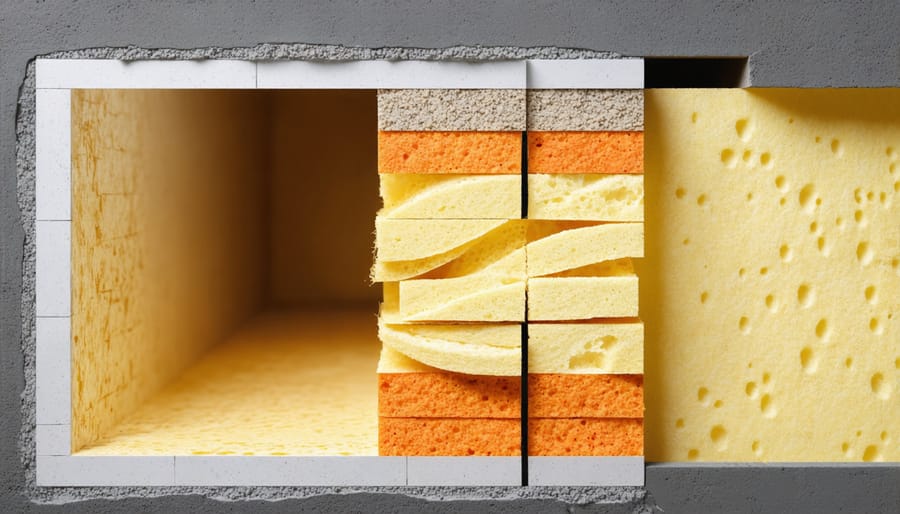
Mushroom and Cellulose Materials
Nature’s own engineering marvels are revolutionizing green insulation through mushroom-based materials and recycled cellulose solutions. Mushroom insulation, also known as mycelium insulation, is created by growing mushroom roots through agricultural waste products. This creates a dense, naturally fire-resistant material that rivals traditional foam insulation in performance while being completely biodegradable.
The process involves cultivating mushroom spores in molds filled with agricultural byproducts like corn stalks or hemp. Over several days, the mushroom mycelium grows through the substrate, creating a solid, lightweight material that’s both durable and sustainable. Once dried, it becomes an effective insulator that’s non-toxic and naturally pest-resistant.
Recycled cellulose, made primarily from post-consumer paper products, offers another outstanding green option. This material is treated with non-toxic fire retardants and pest deterrents, making it safe and effective for both residential and commercial use. It can be either blown in or dense-packed into wall cavities, providing excellent thermal and sound insulation.
Both materials excel at filling irregular spaces and creating airtight barriers, crucial for maximum energy efficiency. They’re particularly appealing for environmentally conscious homeowners, as they require minimal energy to produce and create virtually no waste at the end of their lifecycle. Installation costs are comparable to traditional materials, making them practical alternatives for most building projects.
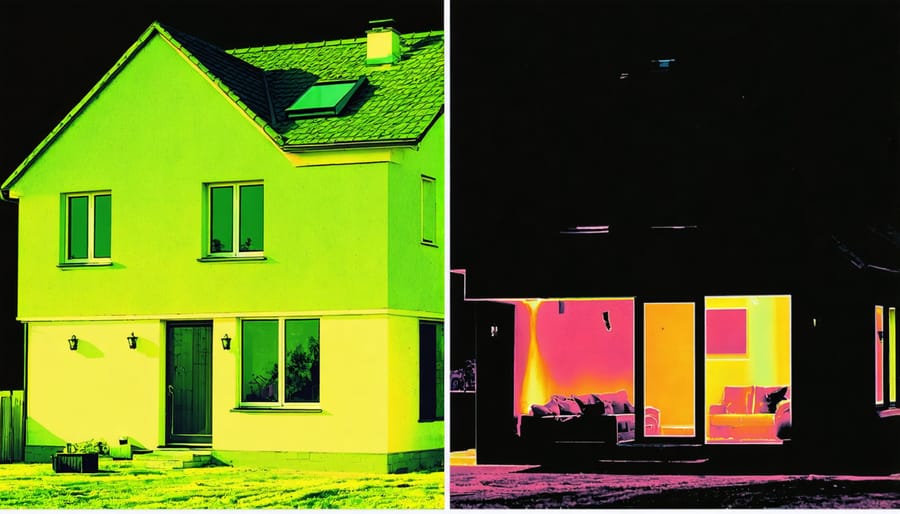
Smart Thermal Technology Integration
Phase-Change Materials
Phase-change materials (PCMs) represent one of the most innovative breakthroughs in green insulation technology. These remarkable materials work by changing their physical state – from solid to liquid and back again – to absorb and release heat, helping to boost energy efficiency in your home.
Think of PCMs as tiny temperature-regulating sponges within your walls. During warm days, they absorb excess heat by melting, preventing your living space from getting too hot. As temperatures cool at night, these materials solidify again, releasing stored heat and maintaining comfortable indoor temperatures.
What makes PCMs particularly exciting for homeowners is their ability to work passively, requiring no electricity or mechanical systems. Common PCM materials include natural substances like plant-based oils and waxes, as well as specially engineered salt hydrates. These can be incorporated into various building materials, from wallboards to ceiling tiles.
The real magic happens in the temperature sweet spot – typically between 68°F and 77°F (20-25°C) – where PCMs are most effective at maintaining consistent indoor temperatures. This natural temperature regulation can reduce your heating and cooling needs by up to 30%, leading to significant energy savings over time.
Installation options include PCM-enhanced drywall, insulation batts, or even specialized pouches that can be retrofitted into existing walls. While the initial cost may be higher than traditional insulation, the long-term energy savings and improved comfort make PCMs an attractive option for sustainable homes.
Temperature-Responsive Barriers
One of the most innovative developments in green insulation technology is the emergence of temperature-responsive barriers. These adaptive systems work like a building’s smart thermostat, automatically adjusting their insulating properties based on external conditions. When integrated with modern smart home technology, these systems can significantly reduce energy consumption while maintaining optimal indoor comfort.
The magic behind these barriers lies in their phase-changing materials (PCMs), which transform from solid to liquid and back again as temperatures fluctuate. During hot days, the PCMs absorb excess heat by melting, preventing it from entering your living space. When temperatures drop at night, the materials solidify and release stored heat back into your home.
These responsive barriers can be installed in various forms, including specialized wallboards, window films, and ceiling tiles. Some popular options include microencapsulated PCM panels that can be easily integrated into existing walls and specially treated fabric barriers that work well in renovation projects.
The real beauty of temperature-responsive barriers is their set-and-forget nature. Once installed, they work automatically without any user intervention, potentially reducing heating and cooling costs by 20-30%. While the initial investment might be higher than traditional insulation, the long-term energy savings and increased comfort make them an attractive option for environmentally conscious homeowners.
Installation and Cost Considerations
DIY vs. Professional Installation
Installing green insulation can be approached in two ways: DIY or professional installation. For simple projects like adding roll insulation to an accessible attic, DIY installation can save money and be a rewarding weekend project. However, more complex solutions like spray foam or structural integrated panels typically require professional expertise.
If you’re considering the DIY route, start by thoroughly researching your chosen material and necessary safety precautions. You’ll need proper protective gear, including a respirator, goggles, and full-coverage clothing. Be prepared to invest in specific tools like a utility knife, tape measure, and possibly a staple gun. Most importantly, ensure you understand local building codes and proper vapor barrier installation.
Professional installation, while more expensive upfront, offers several advantages. Certified installers bring expertise in proper material selection, precise application techniques, and knowledge of building science principles. They’re equipped to handle challenging spaces and can ensure optimal performance through proper air sealing and moisture control. Additionally, many manufacturers’ warranties are only valid with professional installation.
For best results, consider your skill level, project complexity, and budget when choosing between DIY and professional installation. Simple projects can be DIY-friendly, but don’t hesitate to call professionals for more advanced applications.
Long-term Cost Benefits
Investing in advanced green insulation might seem costly upfront, but the long-term financial benefits are substantial. Homeowners typically see a return on investment within 3-5 years through reduced energy bills and increased property value. Studies show that properly installed green insulation can reduce heating and cooling costs by 40-60% annually, leading to significant home energy savings over time.
Let’s break down the numbers: For an average 2,000-square-foot home, green insulation might cost $3,000-$5,000 to install. However, with annual energy savings of $500-$800, the installation cost is often recovered within a few years. Plus, many homeowners qualify for tax incentives and rebates, further reducing the initial investment.
Beyond direct energy savings, green insulation adds value to your property. Real estate experts estimate that homes with advanced insulation solutions can command 3-7% higher resale values. Additionally, the durability of modern green insulation materials means fewer replacement costs over time, with many products lasting 20-25 years or more. When you factor in rising energy costs, the long-term financial benefits become even more attractive.
Maintenance and Durability
Moisture Management
Proper moisture management is crucial for maintaining the effectiveness of green insulation and preventing potential health issues in your home. The key is striking the right balance between insulation performance and moisture control through a multi-layered approach.
Start by ensuring proper ventilation in your home, particularly in high-moisture areas like bathrooms and kitchens. Install vapor barriers on the warm side of your insulation to prevent moisture from penetrating the material. For most climates, this means placing the vapor barrier toward the interior of your home.
Monitor your indoor humidity levels using a simple hygrometer, aiming to maintain levels between 30-50%. During installation, pay special attention to potential condensation points where warm and cold surfaces meet. These areas often require additional ventilation or specialized moisture-resistant materials.
Many green insulation materials, like cellulose and wool, naturally manage moisture better than traditional options. However, they still need proper installation and maintenance. Regular inspections of your insulation, especially after severe weather events, can help catch moisture issues early.
Consider installing smart humidity sensors that can alert you to potential problems before they become serious. If you notice any signs of moisture damage, such as discoloration or musty odors, address them immediately to prevent mold growth and maintain your insulation’s effectiveness.
For crawl spaces and basements, consider using a dehumidifier in conjunction with your insulation system to maintain optimal moisture levels.
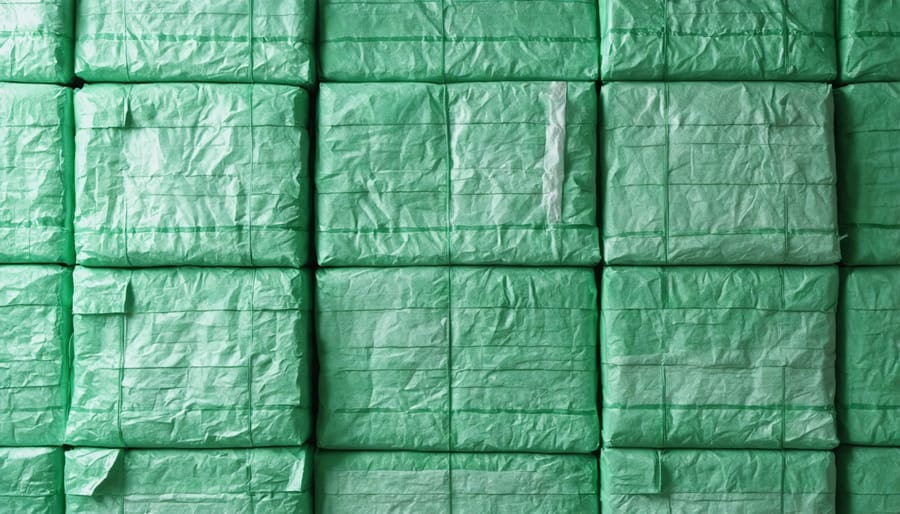
Lifespan and Replacement
Advanced green insulation typically offers exceptional longevity, with most high-quality products lasting 20-25 years when properly installed and maintained. This durability often exceeds traditional insulation materials, making it a smart long-term investment for property owners.
However, several factors can affect your insulation’s lifespan. Moisture exposure, pest infestations, or severe weather events might necessitate earlier replacement. Regular home inspections can help you spot potential issues before they become serious problems. Watch for signs like decreased energy efficiency, uneven indoor temperatures, or visible damage to surrounding walls and surfaces.
To maximize longevity, ensure proper ventilation in your attic and crawl spaces, address any roof leaks promptly, and maintain good air circulation throughout your home. Most green insulation materials are naturally resistant to mold and pests, but annual inspections are still recommended.
Consider replacement when you notice:
– Rising energy bills despite consistent usage
– Indoor temperature fluctuations
– Visible sagging or compression of insulation
– Water damage or discoloration
– Unusual odors in your walls or attic
Many manufacturers offer warranties ranging from 15 to 30 years, depending on the specific product and installation method. Keep your warranty documentation and installation records handy for future reference. When replacement becomes necessary, many green insulation materials can be recycled or repurposed, maintaining their eco-friendly status throughout their lifecycle.
Advanced green insulation represents a significant leap forward in sustainable building practices, offering an impressive combination of environmental benefits and practical advantages. By choosing these innovative materials and methods, property owners can reduce their carbon footprint while enjoying substantial energy savings and improved indoor comfort.
The benefits are clear: lower utility bills, reduced environmental impact, improved indoor air quality, and enhanced property value. Many homeowners report energy savings of 30-50% after upgrading to advanced green insulation solutions, while simultaneously creating healthier living spaces for their families.
Making the switch to green insulation isn’t just about being environmentally conscious – it’s a smart investment in your property’s future. With rising energy costs and increasing awareness of environmental issues, properties with advanced green insulation are becoming more attractive to buyers and tenants alike.
Whether you’re building a new home or upgrading an existing property, the time to consider advanced green insulation is now. The technology continues to improve, installation methods are becoming more streamlined, and costs are increasingly competitive with traditional options. Local incentives and tax breaks often make the transition even more affordable.
Take the first step toward a more sustainable and comfortable living space by exploring your green insulation options. The long-term benefits to both your wallet and the environment make this investment well worth considering.
